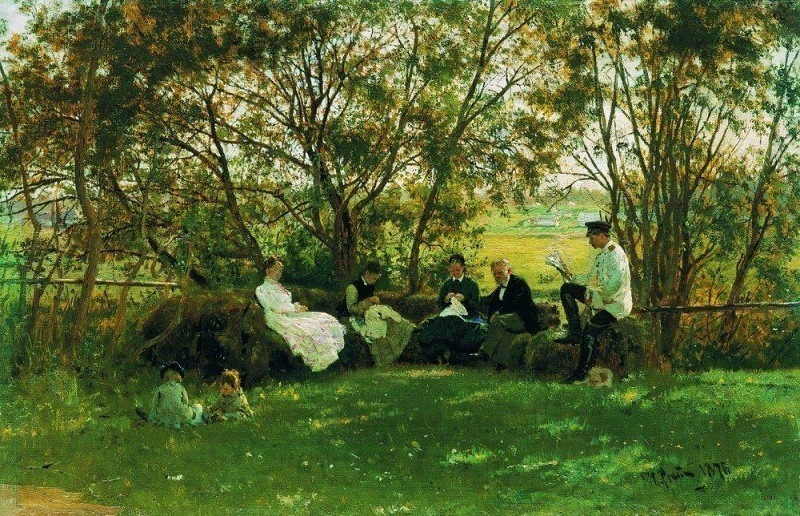On the Turf Bench. Krasnoe Ilya Repin (1844-1930)
Ilya Repin – On the Turf Bench. Krasnoe
Edit attribution
Download full size: 1000×644 px (0,2 Mb)
Painter: Ilya Repin
Location: State Russian Museum, St. Petersburg (Государственный Русский Музей).
Repin’s greatness as an artist is undeniable and requires no proof. The list of the master’s paintings could be listed endlessly - so enormous is it. In 1876 the great variety of subjects in the artist’s personal collection was enriched by one small but very remarkable painting, On a Turf Bench. Repin’s work shows a hot day and his large family sheltered from the sun’s rays in the shade of trees.
Description of Ilya Repin’s painting On a Turf Bench
Repin’s greatness as an artist is undeniable and requires no proof. The list of the master’s paintings could be listed endlessly - so enormous is it.
In 1876 the great variety of subjects in the artist’s personal collection was enriched by one small but very remarkable painting, On a Turf Bench.
Repin’s work shows a hot day and his large family sheltered from the sun’s rays in the shade of trees. It is interesting that Repin did not try to adjust the attitude of the characters in the picture to pose.
It is noticeable that someone is dissatisfied with the fact that he is the object of the artist’s brush. Someone treats indulgently and even ironically. But children do not care about the process - they simply do not notice and behave carelessly and naturally.
Bright colors, which fill all the empty space on the canvas, the summer greenery - inspire a feeling of joy, excitement and peace.
From the perspective of the researcher rather than the philistine, the painting is not just teeming with joyful notes, but also skillfully weaves together several styles, which Repin masterfully learned to use during his studies in France. Impressionism is particularly evident, but skilfully handled with Repin’s special technique of writing.
The master had many such successful works as On a Turf Bench. Interestingly, Repin himself did not attach much importance to such canvases, believing that they had no path to his development as a great artist.
Rather, it was entertainment, recreation, rather than the work itself. The critics of the time were not entirely in agreement with the artist. His peripheral work was valued no less than the masterpiece paintings of the great Russian artist of all time.
Much later, when Repin died, Benois wrote about him not only as an inimitable artist, a master, but also as, a man of great soul, to whom he is grateful.
Кому понравилось
Пожалуйста, подождите
На эту операцию может потребоваться несколько секунд.
Информация появится в новом окне,
если открытие новых окон не запрещено в настройках вашего браузера.
You need to login
Для работы с коллекциями – пожалуйста, войдите в аккаунт (open in new window).




















You cannot comment Why?
On the bench, from left to right, a woman in a white dress sits with her legs crossed, appearing relaxed. Next to her, a woman in a dark dress is engaged in needlework, with a basket of yarn at her feet. Another woman, also in a dark dress, is also seen knitting. To her right, a man in formal attire, a dark coat and lighter trousers, sits contemplating. Further to the right, a military officer in a white uniform, complete with a hat and high boots, is seated and engrossed in reading a newspaper or document.
In the foreground, two young children are playing in the lush green grass adorned with small wildflowers. One child is seated in a light green outfit, while the other is leaning forward.
The backdrop reveals a sunlit rural landscape with fields and some distant structures, suggesting a peaceful village or countryside setting. The overall atmosphere is tranquil and leisurely, capturing a moment of shared relaxation and domestic activity in nature. The juxtaposition of the seemingly quiet, mundane activities of the figures with the vibrant natural setting highlights a harmonious balance between humanity and the environment. The presence of different age groups and social roles (civilians and a military officer) hints at a broader representation of society enjoying a moment of respite.